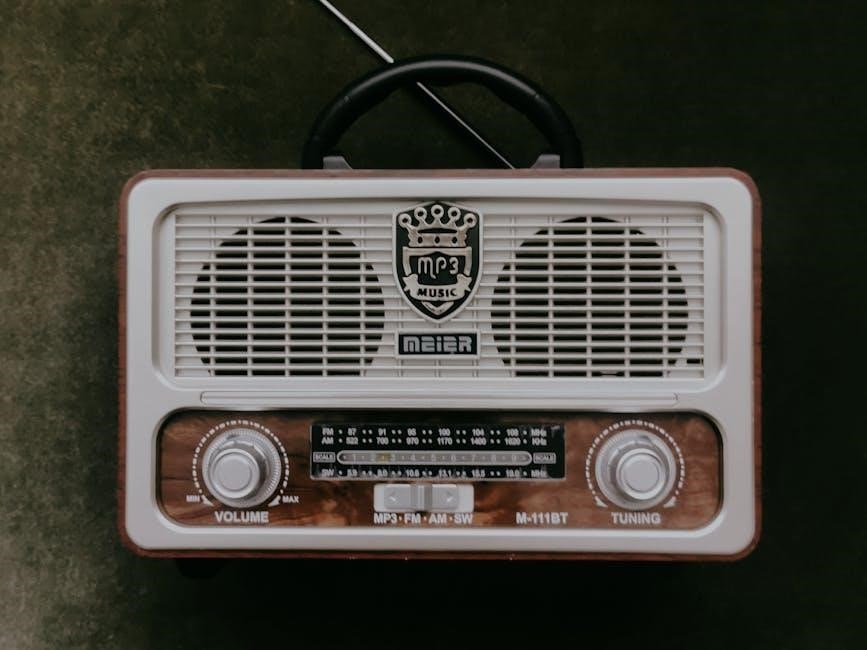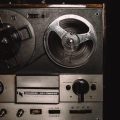sandisk mp3 player manual
Safety Tips and Cleaning Instructions
Handle the device with care to avoid damage. Clean the surface with a soft‚ dry cloth. Avoid exposure to liquids and extreme temperatures. Regularly update firmware for optimal performance.
1.1. General Safety Precautions
Read the manual thoroughly before using your SanDisk MP3 player. Handle the device with care to avoid damage. Avoid exposing the player to liquids‚ extreme temperatures‚ or physical stress. Use only approved accessories to prevent malfunctions. Keep the device away from children and pets. Do not disassemble or modify the player‚ as this may cause permanent damage. Avoid touching internal components or circuitry. Store the device in a dry‚ cool place when not in use. Regularly clean the exterior with a soft‚ dry cloth to maintain functionality. Never expose the player to moisture or submerge it in water. Avoid dropping the device‚ as this may damage internal components. Always ensure the firmware is up to date for optimal performance. Follow these guidelines to ensure safe and efficient use of your SanDisk MP3 player.
1.2. Cleaning the SanDisk MP3 Player
To maintain your SanDisk MP3 player’s performance‚ clean it regularly. Use a soft‚ dry cloth to wipe the exterior and remove fingerprints or smudges. Avoid using liquids‚ chemicals‚ or abrasive materials‚ as they may damage the finish or harm internal components. For the screen‚ gently wipe with a lint-free cloth; avoid applying pressure. Do not insert objects into ports or openings. If debris accumulates in the microSD card slot‚ use compressed air to clean it. Never submerge the device in water or expose it to excessive moisture. Regular cleaning ensures optimal functionality and longevity of your MP3 player. Store it in a protective case when not in use.

Sansa Clip MP3 Player Overview
The Sansa Clip MP3 player is a lightweight‚ portable device designed for music lovers. It features a clip-on design‚ making it ideal for fitness enthusiasts and on-the-go use.
2.1. Key Features of the Sansa Clip
The Sansa Clip MP3 player is a versatile‚ compact device designed for seamless music enjoyment. It features a lightweight‚ clip-on design‚ making it perfect for active use. The player supports various audio formats‚ including MP3‚ WMA‚ and AAC. It also boasts an FM radio‚ allowing users to tune into their favorite stations. With up to 15 hours of battery life‚ it ensures extended playback. The device includes a built-in microphone for voice recording and supports expandable storage via a microSD card slot. Its intuitive interface and customizable settings enhance user experience‚ making it a great choice for music enthusiasts and those seeking more than just basic playback functionality.
2.2. Design and Build Quality
The Sansa Clip MP3 player features a sleek‚ compact design with a lightweight and durable construction. Its small size makes it easy to carry‚ while the clip-on mechanism allows for convenient attachment to clothing. The device is built with high-quality materials‚ ensuring longevity and resistance to everyday wear and tear. The LCD screen is clear and easy to read‚ even in direct sunlight. The controls are ergonomically designed for intuitive navigation‚ with a responsive touch-sensitive interface. The overall build exudes a sense of reliability and sophistication‚ making it both functional and visually appealing for users seeking a portable‚ high-quality music player.

Minimum System Requirements
Ensure your computer meets the minimum requirements for optimal performance: Windows XP/Vista or Mac OS X 10.3 or higher‚ USB 2.0 port‚ and compatible media software.
3.1. Compatible Operating Systems
The SanDisk MP3 player is compatible with a variety of operating systems‚ including Windows XP‚ Vista‚ 7‚ 8‚ and 10‚ as well as Mac OS X 10.3 and later versions. Linux operating systems are also supported in some cases‚ though compatibility may vary depending on the specific distribution. To ensure seamless functionality‚ connect the device to a computer with a USB 2.0 port and install the necessary drivers if prompted. For optimal performance‚ use the Sansa Updater tool provided by SanDisk to manage firmware updates and file transfers. Always verify compatibility with your specific operating system version for the best experience.
3.2. Software Requirements
To fully utilize your SanDisk MP3 player‚ ensure your computer has the necessary software installed. The Sansa Updater tool is essential for firmware updates and file management. For music and media transfer‚ Windows Media Player (version 10 or higher) is recommended. Additionally‚ you may use third-party software like iTunes or Winamp to manage and synchronize your files. For Mac users‚ third-party applications such as XNJB or Clementine can be used to transfer and organize content. Always ensure your software is up-to-date to maintain compatibility and functionality. Using unsupported software may result in errors or incomplete file transfers‚ so stick to recommended programs for optimal performance.

Basic Usage
Turn the device on using the power button. Navigate through menus using the control pad. Use play/pause‚ skip‚ and volume buttons to control music playback. Simple and intuitive.
4.1. Power Button and Turning On/Off
The power button is located on the top of the SanDisk MP3 player. To turn it on‚ press and hold the button until the screen lights up; The LED indicator will glow blue when the device is powered on. If the player is off‚ press the same button until the SanDisk logo appears. The startup process typically takes a few seconds. To turn it off‚ press and hold the power button until the screen goes dark and the LED turns off. This helps conserve battery life. Ensure the device is fully charged before first use for optimal performance.
- Press and hold the power button to turn on/off.
- LED indicator confirms the device is active.
- Startup and shutdown processes are quick and straightforward.
4.2. Navigation and Controls
The SanDisk MP3 player features intuitive navigation controls located on the front of the device. The control pad includes a central select button surrounded by directional buttons (up‚ down‚ left‚ right). Use the directional buttons to scroll through menus or adjust settings. The central button confirms selections or plays/pauses music. The volume control is located on the side‚ allowing users to adjust the sound level easily. To navigate backward‚ press the “Home” button‚ which returns you to the main menu. The controls are responsive and designed for one-handed operation. Use these buttons to access playlists‚ adjust settings‚ or switch between features like music playback and FM radio.
- Central select button for confirming choices or playback control.
- Directional buttons for menu navigation and scrolling.
- Volume control on the side for easy sound adjustment.
- Home button to return to the main menu.


Transferring Music and Files
Transfer music‚ audiobooks‚ and files to your SanDisk MP3 player using a computer via USB. Supported formats include MP3‚ WMA‚ and AAC. Use the provided USB cable for reliable data transfer. Ensure files are organized into folders for easy access. Drag-and-drop functionality simplifies the process. The device supports up to 8GB of storage‚ making it ideal for large music libraries. Always eject the player safely after transferring to avoid data corruption. Compatible with both Windows and macOS systems for seamless file management. Transfer times vary based on file size and computer speed.
- Connect via USB for easy file transfer.
- Supports MP3‚ WMA‚ AAC‚ and more.
- Organize files into folders for quick access.
- Use drag-and-drop for simple transfers.
- Eject safely to prevent data loss.
5.1. Connecting the Player to a Computer
To connect your SanDisk MP3 player to a computer‚ locate the USB port on the device and use the provided USB cable. Plug one end into the player’s USB connector and the other into a free USB port on your computer. The device should be automatically recognized by your operating system. If not‚ ensure the USB cable is securely connected or restart your computer. The player supports USB 2.0 for faster data transfer. Once connected‚ the device will appear in your computer’s file explorer‚ allowing you to transfer music‚ files‚ and other content. Always use the original USB cable for reliable connectivity.
- Use the provided USB cable for connection.
- Plug into a free USB port on your computer;
- Device automatically appears in file explorer.
- Supports USB 2.0 for fast transfers.
- Ensure secure connection for proper recognition.
5.2. Loading Music and Other Contents
To load music or other files onto your SanDisk MP3 player‚ open the device in your computer’s file explorer after connecting it via USB. Locate your music files or other content on your computer and drag and drop them into the player’s folders. The device supports MP3‚ WMA‚ and other audio formats. You can also organize files into folders for better management. Ensure the files are compatible with the player to avoid playback issues. Once transferred‚ safely eject the device from your computer before disconnecting. This ensures data integrity and prevents corruption of files during transfer.
- Drag and drop files into the player’s folders.
- Supports MP3‚ WMA‚ and other audio formats.
- Organize files into folders for easy access.
- Ensure files are compatible for proper playback.
- Safely eject the device after transferring files.
5.3. Organizing Files and Folders
Organizing files and folders on your SanDisk MP3 player helps you quickly access your music and other content. Create folders for different genres‚ artists‚ or playlists by right-clicking in the device’s folder and selecting New Folder. Drag and drop files into these folders using your computer’s file explorer. For efficient navigation‚ ensure filenames are clear and descriptive. Avoid using special characters‚ as they may cause compatibility issues. After organizing‚ disconnect the device safely by ejecting it from your computer to prevent data loss. Proper organization enhances your listening experience and makes managing files easier.
- Create folders for genres‚ artists‚ or playlists.
- Use clear‚ descriptive filenames without special characters.
- Eject the device safely after organizing files.
- Proper organization improves navigation and listening experience.

Playing Contents
Enjoy your music‚ audiobooks‚ and FM radio seamlessly. Navigate playlists‚ adjust settings‚ and customize your listening experience with intuitive controls for optimal entertainment on the go.
6.1. Playing Music and Audiobooks
Start by selecting your desired file from the music or audiobook folder. Use the play/pause button to begin playback. Navigate tracks using the skip buttons‚ and adjust volume with the side controls. The player supports formats like MP3‚ AAC‚ and Audible for audiobooks. For audiobooks‚ enable the bookmark feature to resume from where you left off. Use the lock button to prevent accidental button presses during playback. Organize files into folders for easy access‚ and create playlists for personalized listening experiences. Ensure headphones are properly connected for optimal sound quality. Enjoy seamless playback with intuitive controls designed for convenience and efficiency.
6.2. Navigating Through Playlists
Navigate through playlists using the directional buttons on the Sansa Clip. Press the forward or backward buttons to skip tracks or scroll through your playlist. To access the playlist menu‚ press the center button. Use the volume controls to adjust the playback level. You can shuffle songs by selecting the “shuffle” option in the settings menu. To repeat a track‚ navigate to the repeat feature and select it. Organize your playlists by creating folders on your computer and transferring them to the player. This ensures easy access to your favorite tracks. Use the lock button to prevent accidental changes during playback.
6.3. Using the FM Radio Feature
To use the FM radio on your SanDisk MP3 player‚ navigate to the “Radio” option in the main menu. Ensure your headphones are connected‚ as they act as the antenna. Select “Auto Scan” to search for available stations. Weak signals can be improved by adjusting the headphone position. Save favorite stations using the “Preset” feature for quick access. Use the forward and backward buttons to change stations or manually tune using the directional buttons. Adjust the volume with the volume controls. Note that the FM radio feature may not be available in all regions or models. Refer to your specific model’s manual for exact instructions.

Managing and Deleting Files
Connect the player to your computer to manage files. Use file explorer to delete unwanted files or organize folders. Avoid deleting system files to maintain functionality.
7;1. Deleting Files from the Player
To delete files from the SanDisk MP3 player‚ connect it to your computer using a USB cable. Once connected‚ the player will appear in your computer’s file explorer or finder. Navigate to the “Music” folder or other relevant directories where your files are stored. Select the files you wish to delete and press the Delete key on your keyboard or right-click and choose Delete. Avoid deleting system or firmware files‚ as this may affect the player’s functionality. After deleting‚ safely eject the device from your computer to ensure no data corruption occurs. You can also delete files directly from the player using its menu‚ though this method is more limited.
7.2. Formatting the Device
Formatting the SanDisk MP3 player will erase all data and restore it to factory settings. Before proceeding‚ ensure all important files are backed up to your computer. Connect the player to your computer via USB and open the file explorer. Right-click on the player’s drive‚ select Format‚ and choose FAT32 as the file system. Click Start to begin the process. Formatting may take a few minutes. Once complete‚ the player will be empty and ready for new content. Note that formatting will also reset all settings to default. If using a Mac‚ use the Disk Utility application to format the device. Always safely eject the device after formatting to prevent data corruption.

Customizing Settings
Customize your SanDisk MP3 player’s settings to enhance your experience. Adjust equalizer presets‚ sound effects‚ and display brightness to suit your preferences for optimal listening and viewing comfort.
8.1. Equalizer and Sound Settings
The SanDisk MP3 player allows you to customize your audio experience with an equalizer and sound settings. Access the equalizer by navigating to the Settings menu and selecting Sound or Equalizer. Choose from predefined presets like Rock‚ Jazz‚ Classical‚ or Pop to enhance your music. You can also adjust bass‚ treble‚ and balance to tailor the sound to your preference. Some models offer additional features like SRS WOW HD for enhanced clarity and depth. Experiment with these settings to optimize your listening experience. Save your preferred configuration for seamless playback across different genres and audio files.
8.2. Display Settings and Brightness
Adjust the display settings and brightness on your SanDisk MP3 player to enhance visibility and conserve battery life. Navigate to the Settings menu‚ then select Display or Display Settings. Here‚ you can modify brightness levels using a sliding scale or predefined options. Some models allow you to enable or disable the backlight‚ set a backlight timer‚ or adjust the screen’s contrast for better readability. You may also customize the display theme or font size for a personalized experience. Optimize these settings based on your environment to ensure clear visibility while minimizing power consumption. Experiment with different configurations to find your ideal balance between visibility and battery efficiency.
Advanced Features
The SanDisk MP3 player offers advanced features like voice recording‚ audiobook support‚ and customizable equalizer settings to enhance your listening experience and versatility of use.
9.1. Voice Recording and Microphone
The SanDisk MP3 player includes a built-in microphone for voice recording‚ enabling users to capture lectures‚ meetings‚ or personal notes; To start recording‚ navigate to the voice recording option in the menu‚ select “Start‚” and speak into the microphone. The device will save recordings as MP3 files in a designated folder. For optimal quality‚ ensure the player is in a quiet environment and the microphone is not obstructed. You can pause or stop recording using the controls. Recordings can be played back directly on the device or transferred to a computer for storage or editing. This feature adds versatility to the player’s functionality‚ making it useful beyond music playback.
9.2. Audiobook Support
The SanDisk MP3 player supports audiobook playback‚ allowing users to enjoy their favorite books on the go. The device is compatible with popular audiobook formats‚ including MP3‚ AAC‚ and Audible. To load audiobooks‚ simply drag and drop the files into the designated “Audiobooks” folder on the player when connected to a computer. The player automatically recognizes these files and organizes them for easy access. During playback‚ features like resume play and adjustable speed ensure a seamless listening experience. Additionally‚ the device supports bookmarking‚ enabling users to pick up where they left off. This feature makes the SanDisk MP3 player an excellent choice for audiobook enthusiasts.
Maintenance and Troubleshooting
Regularly update firmware for optimal performance. Reset the device to resolve minor issues without data loss. Clean the player to prevent dust buildup. Troubleshoot freezes by restarting or charging. Check for corrupted files and ensure proper file formatting for smooth operation.
10.1. Updating Firmware
Regular firmware updates ensure your SanDisk MP3 player runs smoothly and efficiently. To update‚ connect the device to your computer using a USB cable. Visit the official SanDisk website‚ download the latest firmware version‚ and follow the on-screen instructions. Ensure the player is fully charged before starting the update. Back up your data beforehand‚ as updating may erase stored files. Updating firmware improves compatibility with audio formats‚ enhances user interface features‚ and fixes potential bugs. After installation‚ restart the device to apply changes. Regular updates are crucial for maintaining optimal performance and accessing new features. Always use official sources to avoid unauthorized software.
10.2. Common Issues and Solutions
Common issues with the SanDisk MP3 player include freezing‚ files not showing up‚ or battery life concerns. If the device freezes‚ restart it by holding the power button for 10 seconds. For missing files‚ ensure they are in a compatible format and transferred correctly using the correct USB mode (MSC or MTP). Battery life issues may arise from overcharging; avoid leaving it plugged in overnight. If the player isn’t detected by your computer‚ try a different USB port or cable. For audio issues‚ check headphone connectivity or volume settings. Resetting the device to factory settings can resolve persistent problems. Always refer to the troubleshooting guide in the manual or contact support for unresolved issues.

Warranty and Support Information
The SanDisk MP3 player is backed by a one-year limited warranty covering manufacturing defects. For support‚ visit the official SanDisk website or contact their customer service team.
11.1. Warranty Details
Your SanDisk MP3 player is protected by a limited one-year warranty starting from the date of purchase. This warranty covers defects in materials and workmanship under normal use. Damage caused by misuse‚ accidents‚ or unauthorized modifications is not covered. To claim warranty service‚ you must provide proof of purchase and contact SanDisk support. The warranty is non-transferable and only applies to the original purchaser. For more details‚ refer to the warranty documentation included with your device or visit the official SanDisk website. Additionally‚ some regions may offer extended warranty options or special programs‚ so check your local support resources for further information.
11.2. Contacting SanDisk Support
To contact SanDisk support‚ visit the official SanDisk website and navigate to the support page. From there‚ you can access a variety of resources‚ including FAQs‚ user manuals‚ and troubleshooting guides. For direct assistance‚ use the contact form or live chat feature available on the website. You can also reach SanDisk support via phone or email‚ depending on your region. Be sure to have your product serial number ready when contacting support to expedite the process. Support is typically available 24/7‚ but response times may vary based on your location and the nature of your inquiry. For the most efficient help‚ ensure you describe your issue clearly and provide all relevant details.
Glossary of Terms
This section defines key terms related to the SanDisk MP3 player‚ such as MP3‚ codec‚ bitrate‚ playlist‚ and DRM‚ to help users understand technical concepts clearly.
12.1. Understanding MP3 Player Terminology
Understanding key terms is essential for using your SanDisk MP3 player effectively. MP3 stands for MPEG Audio Layer 3‚ a popular audio format. Codec refers to software that encodes or decodes audio files. Bitrate measures audio quality‚ with higher rates offering better sound. Playlist is a collection of songs or files organized for playback. DRM (Digital Rights Management) protects files from unauthorized use. Firmware is the device’s internal software‚ and formatting erases all data on the player. Familiarizing yourself with these terms will enhance your user experience and troubleshooting abilities. Always refer to this glossary for clarification of technical terms.
Mastering your SanDisk MP3 player enhances your music experience. Follow guidelines‚ explore features‚ and maintain your device for optimal performance. Enjoy your portable music companion!
13.1. Final Tips for Optimal Use
To get the most out of your SanDisk MP3 player‚ keep it updated with the latest firmware for improved performance. Regularly organize your files and playlists to ensure easy access to your content. Use the equalizer settings to customize your sound experience according to your preferences. Avoid exposing the device to extreme temperatures or moisture to maintain its longevity. For the best audio quality‚ use high-resolution music files and compatible headphones. Explore all features‚ such as voice recording and FM radio‚ to maximize functionality. Refer to the manual for troubleshooting common issues and maintaining your device in top condition.
13.2. Resources for Further Assistance
For additional support‚ visit the official SanDisk website‚ which offers comprehensive guides‚ FAQs‚ and downloadable manuals. The SanDisk support page provides detailed troubleshooting steps and software updates. Users can also access community forums to share experiences and solutions with other owners. Contacting SanDisk customer support directly is another reliable option for personalized assistance. Ensure to register your device to benefit from warranty services and exclusive updates. Exploring these resources will help you maximize your MP3 player’s potential and resolve any issues efficiently. Regularly check for firmware updates to keep your device functioning optimally. These resources are designed to enhance your overall user experience with the SanDisk MP3 player.


